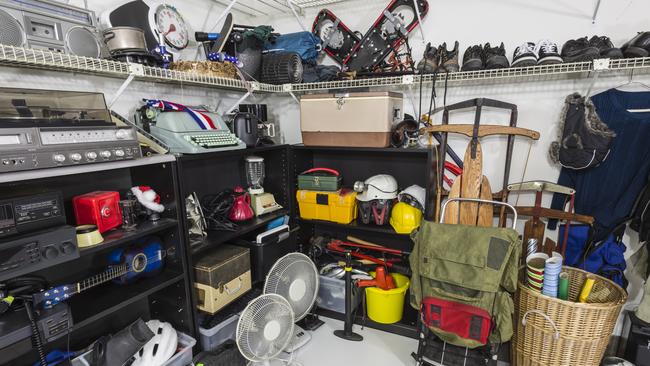
It is a condition of modern life that has gathered momentum over decades, and it is showing no sign of abating. It is the steady accumulation of stuff, junk, the detritus of modern living that has fallen out of favour, fashion or usage but which for some reason is considered too good to throw out. And it’s everywhere.
Let’s start with the garage (if you have one). I suspect for most people it serves as storage facility rather than motor vehicle accommodation. Today’s garage captures overflow; it’s like a spillway for a consumerist household. The house itself might be an exemplar of chic, minimalist living but this fashionable look can only be achieved by shuffling “stuff” into a garage.
To be fair, there are more drivers to the accumulations of modern life than consumption. The modern trend of young adult children leaving home to travel, to live in share houses, to trial relationships in rented accommodation means there’s a real need for the medium-term storage of books, bikes, surfboards and endless boxes of stuff.
I have a theory that a household accumulates roughly 10 per cent more stuff than the available storage capacity, and that figure rises by one percentage point every year. There’s junk in the garage, in the spare room (whose door shall always remain closed), in umpteen cupboards and drawers.
I suspect part of the reason Australians like to travel is the cleansed feeling they get when staying in places where the cupboards and drawers are empty. All that melamine, gleaming and white, smelling so lemony fresh. Oh, don’t you wish your cupboards looked and smelt like this? Yes, yes, yes!
Every kitchen has a junk drawer. There are utensils there that have no known purpose; they simply exist, daring you to summon up the courage to throw them out. Only to find a week later that you desperately need that egg ring, food processor attachment or apple corer.
And then there’s the wardrobe, a super spreader of consumerist detritus. Furniture might need to be replaced every decade or so but clothes come and go by the season and there’s the tricky issue of hanging on to an outfit that once fitted so well. The modern wardrobe must accommodate new clothes as well as relics whose sole purpose is to keep alive the forlorn belief that eventually, as on judgment day, you will rise up, sleek, slim and supple, and effortlessly fit into that outfit. To throw it out is to admit those days are gone. So, we need bigger wardrobes; in fact, we need walk-in wardrobes to store ever more stuff.
I do not recall household storage being an issue when I was growing up in the 1960s. The Great Depression and World War II cast a long shadow that for decades cultivated a prevailing culture of thrift and frugality. The great consumer shift enabling households to expand, to afford appliances, outfits, furniture that could be updated, came in the 1980s. Houses expanded; garages (and bathrooms) doubled. Whether a household was two-car and/or double-income was greatly discussed. We embraced consumerism enthusiastically. Its corollary – the accumulation of junk – would surface a generation later.
As a result, many in the new millennium have embraced minimalist design, the big downsizing, the big cleanout. The more consumerist we have become, the more acquisitive, the more avaricious, the more fervently we go on to pursue the ideal of living uncluttered and unfettered lives. But hidden away behind the scenes – rather like human flaws and failings – lies the clutter, the detritus that is the stuff of modern life.



